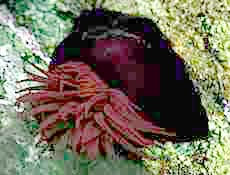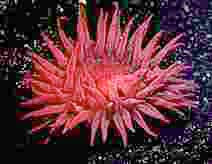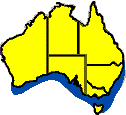|
|

Waratah Anemone Actinia tenebrosa
Form:
 The
Waratah Anenome's column is
smooth and squashed. It's many food gathering tentacles
are short and tapered.
The
Waratah Anenome's column is
smooth and squashed. It's many food gathering tentacles
are short and tapered.
At the base of the tentacles on the column, are small bumps which are called spherules. These spherules contain stinging nematocysts which can be injected or fired into prey animals to immobilise them.
Colour:
 The
column of the Waratah Anemone
is rich red, while the central oral
disk is light red in colour. The
tentacles are also bright
red.
The
column of the Waratah Anemone
is rich red, while the central oral
disk is light red in colour. The
tentacles are also bright
red.
The Waratah Anenome is a distinctively coloured anemone. The nematocyst-bearing spherules on the column are an iridescent blue.
Phylum: |
Cnidaria |
Author: |
Farquhar, 1898 |
Family: |
Actiniidae |
Size: |
40 mm diameter |
Distribution:
 The
Waratah Anemone ranges from New South Wales, across Victoria and South
Australia, Tasmania to southern Western Australia. It also occurs in New
Zealand.
The
Waratah Anemone ranges from New South Wales, across Victoria and South
Australia, Tasmania to southern Western Australia. It also occurs in New
Zealand.
Habitat:
The Waratah Anenome is found at mid to low-tide levels in crevices and the undersurfaces of rocks on semi-protected and exposed rocky shores. Sometimes Waratah Anemones can be found quite high on a shore, or may be seen in quite exposed conditions.
Biology:
The Waratah Anemone is most often seen in its contracted globular state, where all its tentacles and mouth region are drawn in, so that it looks like a blob of dark brown jelly with a hole on the middle. It is amazing just how much drying out a Waratah Anemone can withstand.
The Waratah Anemone is viviparous which means that it broods its live young inside the column between the septa wall partitions.
When the young have grown tentacles, they are ejected out of the mouth by contractions of the parent's column. The young anemones then settle close to their parents.
When adult anemones occur alongside one another, an individual can tell if the other anemone is related to itself, or not. If it is not related, one adult may attack and devour parts of the other.
Anemones do not remain stuck to one spot. Although imperceptibly slow, they do glide over the rock surface towards food or to attack other adult Waratah Anemones.
References:
Bennett, I. (1987) W. J. Dakin's classic study: Australian Seashores. p.173, Angus & Robertson, Sydney.
Davey, K. (1998) A Photographic Guide to Seashore Life of Australia. p.31, New Holland, Sydney.
Edgar, G. J. (1997) Australian Marine Life: the plants and animals of temperate waters. p.126, Reed Books, Kew.
Quinn, G. P., Wescott, G. C. & Synnot, R. N. (1992) Life on the Rocky Shores of South-eastern Australia: an illustrated field guide. p26, Victorian National Parks Association, Melbourne.
Marine Research Group of Victoria (1984) Coastal Invertebrates of Victoria: an atlas of selected species. p.10, Museum of Victoria, Melbourne.
Shepherd, S. A. & Thomas, I. M (1982) Marine Invertebrates of Victoria, Pt. 1. p.166, South Australian Government Printer, Adelaide.
Waratah
Anemone
Eastern Sand Anemone
Home
Page
Taxonomy
Biogeography
Rocky Shores
Tidal Levels
Intertidal Zonation
Environmental Factors
Biological
Factors
Feeding Relationships
Activities
Glossary
References
 Life
on Australian Seashores
Life
on Australian Seashores
by Keith Davey (C) 2000
Learning Consultant
- Media
The University of Newcastle
email at australian_seashores@hotmail.com
Scientific Consultant: Phil
Colman
site created 01.01.98 : updated 01.04.2000